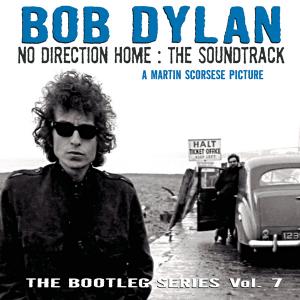
The Bootleg Series, Vol. 7: No Direction Home - The Soundtrack (2005)

Disc One
1. When I Got Troubles
2. Rambler, Gambler
3. This Land is Your Land
4. Song to Woody
5. Dink's Song
6. I Was Young When I Left Home
7. Sally Gal
8. Don't Think Twice, It's All Right
9. Man of Constant Sorrow
10.Blowin' in the Wind
11.Masters of War
12.A Hard Rain's A-Gonna Fall
13.When the Ship Comes In
14.Mr. Tambourine Man
15.Chimes of Freedom
16.It's All Over Now, Baby Blue
Disc Two
1. She Belongs To Me
2. Maggie's Farm
3. It Takes a Lot To Laugh, It Takes a Train To Cry
4. Tombstone Blues
5. Just Like Tom Thumb's Blues
6. Desolation Row
7. Highway 61 Revisited
8. Leopard-Skin Pill-Box Hat
9. Stuck Inside of Mobile with the Memphis Blues Again
10.Visions of Johanna
11.Ballad of a Thin Man
12.Like a Rolling Stone
By the time the seventh volume of Bob Dylan’s Bootleg Series emerged, the sense of revelation that accompanied the earlier entries had noticeably dulled. In contrast to the richly layered and essential rarities of the inaugural collection, this edition feels more archival than essential—less a dynamic rediscovery than a respectful rummage through well-tread territory.
Ostensibly issued as a soundtrack to Martin Scorsese’s PBS documentary No Direction Home, the album sits in a curious position. While the film was a comprehensive and often electrifying portrait of Dylan’s transition from folk prophet to electric iconoclast, the musical component—this two-disc set—doesn’t always carry the same narrative clarity or dramatic arc. The association feels more nominal than necessary. Yes, the recordings span the same critical years (1961–1966), but the cohesion ends there.
Disc one is largely acoustic, drawing from Dylan’s early Greenwich Village period. There’s an intimacy here—yes—but also a palpable sense of repetition. The demos and alternate takes, while historically notable, lack the emotional punch or musical freshness that made earlier Bootleg entries revelatory. Even a reading of This Land is Your Land—surely a potent choice in theory—lands with all the energy of a nodding folk club. By track three, inertia sets in.
The second disc turns electric, reflecting the infamous and much-mythologized rupture with his purist fanbase. Yet even here, the alternate takes and lengthy renditions (some pushing seven minutes) feel more dutiful than illuminating. The sense of danger that clung to Dylan’s electric period—the “Judas!” yells, the blurry line between evolution and provocation—is mostly absent. These tracks are cleaned-up artifacts rather than visceral experience.
Still, for all the critical reservation, there’s no denying the historical significance. Dylan was at his most influential during this period, and even his discarded takes offer glimpses of the ferocity and fearlessness that defined his mid-sixties zenith. Much like The Beatles’ Anthology series, No Direction Home offers a behind-the-curtain view—not always thrilling, but often quietly revealing.
It is not a record one returns to for pleasure or pacing. Rather, it is a document—one that rewards context more than repetition. In that sense, it succeeds not as a standalone album, but as a shadow companion to the greater Dylan mythos, and to the Scorsese film that attempted, admirably, to capture it.
Go back to the main page
Go To Next Review